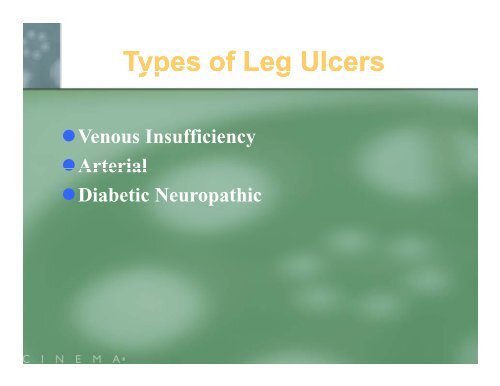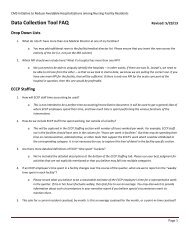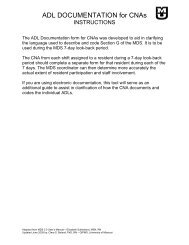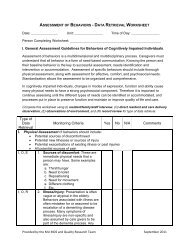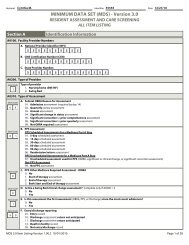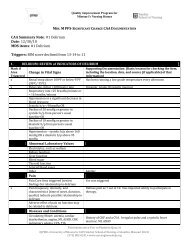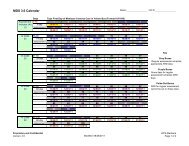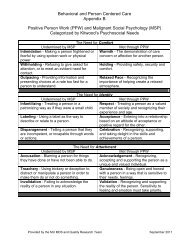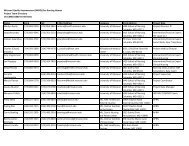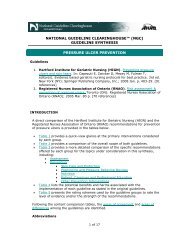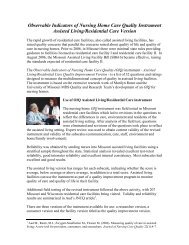Venous Insufficiency Ulcer - Nursing Home Help
Venous Insufficiency Ulcer - Nursing Home Help
Venous Insufficiency Ulcer - Nursing Home Help
You also want an ePaper? Increase the reach of your titles
YUMPU automatically turns print PDFs into web optimized ePapers that Google loves.
Types of Leg <strong>Ulcer</strong>s•<strong>Venous</strong> <strong>Insufficiency</strong>•Arterial•Diabetic Neuropathic
<strong>Venous</strong> <strong>Insufficiency</strong>•Previously known as “stasis ulcer”•An open lesion of the skin andsubcutaneous tissue of the lower leg,usually occurring in the pretibial area ofthe lower leg or above the medial ankle.
<strong>Venous</strong> <strong>Insufficiency</strong> <strong>Ulcer</strong>
Vascular Problems•Incompetent venoussystem of the legs•Increased fibroustissue•Hyperpigmentation(Hemosiderin)
Chronic stasisdermatitis•Increasedvenouspressureinduced byincompetentvalves•Inducesinflammation
Acute stasis dermatitis
Underlying Condition• <strong>Venous</strong> <strong>Insufficiency</strong> <strong>Ulcer</strong>– Previous DVT & varicosities– Reduced mobility– Obesity– Vascular ulcers– Phlebitis– Traumatic injury– CHF– Orthopedic procedures– Pain reduced by elevation
Characteristics•<strong>Venous</strong> <strong>Insufficiency</strong> Wound Bed– Ruddy base– Usually shallow– Moderate to heavy exudate– Granulation tissue frequently present
Characteristics•<strong>Venous</strong> <strong>Insufficiency</strong> <strong>Ulcer</strong>– <strong>Ulcer</strong> edges: irregular– Shape: irregular– Surrounding tissue: erythema and /or brownstaining– Location: Medial aspect of lower leg andankle, superior to medial malleolus
Perfusion•<strong>Venous</strong> Insufficency <strong>Ulcer</strong>– Pain: minimal unless infected or desiccated– Peripheral pulses: present/palpable– Capillary refill: normal-less than 3 seconds
TreatmentImprove <strong>Venous</strong> Return By:•Surgical obliteration of damaged veins•Elevation of legs•Compression C i therapy to provide at least30mm hg compression @ ankle– Example: Unna boot or therapeutic ti supportstockings
Topical Therapy•<strong>Venous</strong> <strong>Insufficiency</strong> <strong>Ulcer</strong>– Absorb exudate– Maintain moist wound surface
Arterial <strong>Ulcer</strong>•Is an ulceration that occurs as the resultof arterial occlusive disease when nonpressurerelated disruption or blockage ofthe arterial blood flow to an area causestissue necrosis.
Arterial <strong>Ulcer</strong>
Underlying Condition• Arterial <strong>Ulcer</strong>– Diabetes– Anemia– Arthritis– Increased pain with activity and/or elevation– CVA– Smoking– Intermittent claudication– Traumatic injury to extremity
Underlying Condition•Arterial <strong>Ulcer</strong> continued– Vascular procedures/surgeries– Hypertension– Hyperlipidemia– Arterial disease
Characteristics•Arterial <strong>Ulcer</strong> Wound Bed– Base of wound, pale/pallor on elevation;dependent d rubor– Deep– Minimal exudate– Granulation tissue rarely present– Necrosis, eschar, gangrene may be present
Characteristics•Arterial <strong>Ulcer</strong>– <strong>Ulcer</strong> edges: even– Shape: round– Surrounding tissue: skinny, taut, thin, dry,hair loss of lower extremities, atrophy ofsubcutaneous tissue– Location: Toe tips or web spaces, phalangealheads around lateral malleolus
Perfusion•Arterial <strong>Ulcer</strong>– Pain: intermittent claudication, resting,positional, nocturnal– Peripheral pulses: absent or diminished– Capillary refill: delayed-more than 3seconds, ABI < 0.8
TreatmentImprove Tissue Perfusion By:•Revascularization if possible•Medications to improve RBC transitthrough narrowed vessels•Lifestyle changes (ex. no tobacco orcaffeine)•Improve hydration•Appropriate footwear to prevent trauma
Topical Therapy•Arterial <strong>Ulcer</strong>– Uninfected wound: keep dry– Infected wound: immediate referral forsurgical debridement/ aggressive antibiotictherapy– Open: Moist wound healing, non-occlusivedressing or cautious use of occlusivedressings, aggressive treatment of anyinfection
Diabetic Neuropathic <strong>Ulcer</strong>•Characteristically occurs on the foot e.g.at mid-foot, at the ball of the foot over themetatarsal heads, or on the tops of toeswith Charcot deformity.•Requires that the resident be diagnosedwith diabetes mellitus and haveperipheral neuropathy.
Diabetic Neuropathic <strong>Ulcer</strong>
Underlying Condition•Diabetic neuropathic ulcer– Diabetes– Spinal cord injury– Hansen’s disease– Relief of pain with ambulation– Parasthesia of extremities
Characteristics•Diabetic Neuropathic <strong>Ulcer</strong> Wound Bed– Variable depth– Variable exudate– Granulation tissue frequently present– Gangrene uncommon, necrotic tissuevariable
Characteristics•Diabetic Neuropathic <strong>Ulcer</strong>– <strong>Ulcer</strong> edges: well defined– Shape: variable– Surrounding tissue: normal skin tones,fissuring and/or callus formation– Location: Plantar aspect of foot, metatarsalheads, heels
Perfusion•Diabetic Neuropathic <strong>Ulcer</strong>– Pain: diminished sensitivity to touch– Peripheral pulses: palpable/present– Capillary refill: normal
TreatmentMeasures to eliminate trauma•Appropriate footwear•“Offloading” for plantar ulcers•Tight i glucose control•Aggressive infection control
Topical Therapy•Diabetic Neuropathic <strong>Ulcer</strong>s– Cautious use of occlusive dressings– Dressing to absorb exudate/keep surfacemoist
References:• American Medical Directors Association. Pressure<strong>Ulcer</strong>s in the Long Term Care Setting Clinical PracticeGuidelines. Columbia, MD:AMDA 2008.• Berstrom, N., Demuth, P., & Braden, B. (1987). Aclinical trial of the Braden scale for predicting pressuresore risk. <strong>Nursing</strong> clinics of North America, 22(2), 417-424.• National Pressure <strong>Ulcer</strong> Advisory Panel. (1995).Position on reverse staging of pressure ulcers. NPUAPReport 4, no. 2:32-33. 33.• National Pressure <strong>Ulcer</strong> Advisory Panel. (2007)Pressure<strong>Ulcer</strong> stages Revised by NPAUP
References:• U.S. Department of Health and HumanServices: Agency for Health Care Policy andResearch. (1992). Clinical practice guidelines:Pressure ulcers in adults: Prediction andprevention. (AHCPR 92-0050) 0050). Rockville, MD• U.S. Department of Health and HumanServices: Agency for Health Care Policy andResearch. (1994). Clinical practice guidelines:Pressure ulcer treatment. (AHCPR 95-0653).Rockville, MD• http://www.globalwoundacademy.com/l d /


